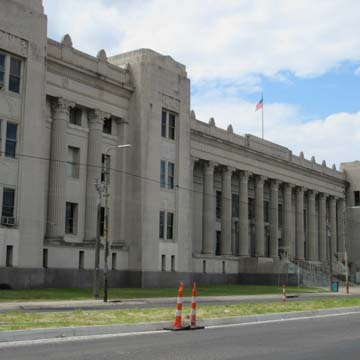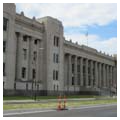Architect Allison Owen stated that his design for the Criminal Courts Building represented two characteristics of the law: “elegance reflected in the classical colonnade and severity reflected in . . . modern buttresses.” The result does suggest that two eras have collided: a massive twelve-columned classical temple book-ended between doubled pavilions (Owen’s “buttresses”) of Egyptian shape and proportions and with Art Deco ornament. The building is faced with limestone and adorned with bronzed cast-iron panels between the windows that depict scenes from local history, stylized pelicans (Louisiana’s state bird) in relief, and anthemia carved near the summit of the pavilions, all designed by New Orleans artist Angela Gregory (1903–1990). The courthouse entrance, at the center of the long side, is reached by way of a tall flight of granite steps passing through the colonnade. From a small marble lobby, stairs lead up to the great marble hall that extends the length of the building and gives access to seven two-story-high courtrooms. Architect Owen likened the great barrel-vaulted hall to the early-seventeenth-century Salle des Pas Perdus of the Palais de Justice in Paris; although the details differ, the overall appearance and effect are similar. Huge Art Deco chandeliers of bronze and opalescent glass illuminate the walls of veined black and cream-colored marble and the dusky pink marble floor. The hall’s epic scale and luxuriant materials, as well as the noise that rebounds from the hard surfaces, are more than enough to awe both defendants and lawyers. District Attorney Jim Garrison’s prosecution of Clay Shaw, who was accused and acquitted in connection with the assassination of President John F. Kennedy (a unanimous verdict took just fifty-four minutes), took place here in 1969.
You are here
Criminal Courts Building
If SAH Archipedia has been useful to you, please consider supporting it.
SAH Archipedia tells the story of the United States through its buildings, landscapes, and cities. This freely available resource empowers the public with authoritative knowledge that deepens their understanding and appreciation of the built environment. But the Society of Architectural Historians, which created SAH Archipedia with University of Virginia Press, needs your support to maintain the high-caliber research, writing, photography, cartography, editing, design, and programming that make SAH Archipedia a trusted online resource available to all who value the history of place, heritage tourism, and learning.


















